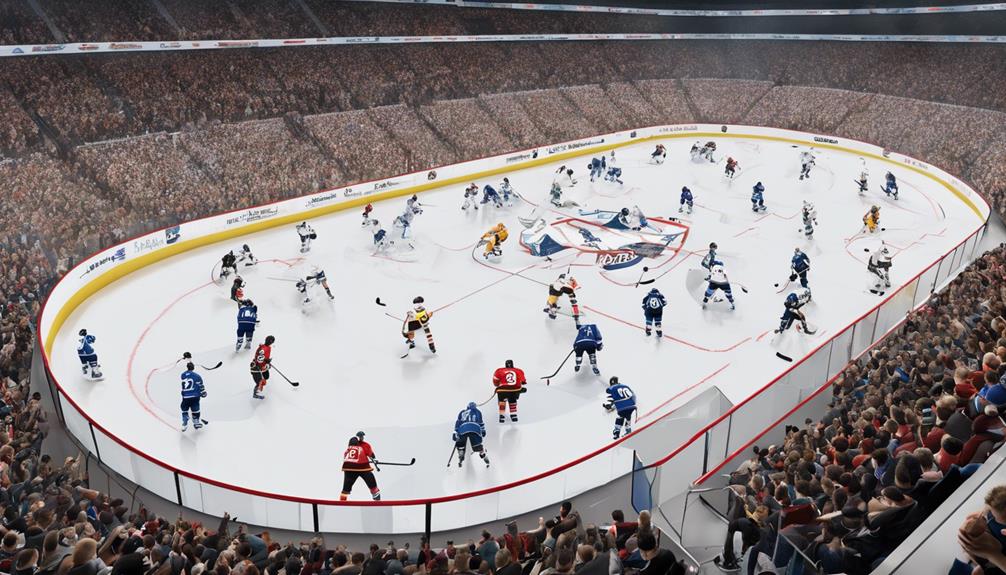The National Hockey League (NHL) is home to a multitude of talented athletes who showcase their skills on the ice every season. Have you ever stopped to ponder the exact number of players that make up the league? The answer might surprise you and shed light on the depth of talent and competition within the NHL.
Understanding the roster sizes, positions, and overall player demographics can provide insight into the inner workings of this fast-paced and dynamic sport. Stay tuned to uncover the intricate details surrounding the number of players in the NHL and how it impacts the game as a whole.
NHL Rosters: How Many Players Per Team?
In the National Hockey League (NHL), each team typically consists of a roster of 23 players. These team sizes are carefully selected to ensure a balance of skills and positions within the squad.
Player rotations are crucial in the NHL to maintain the team's performance throughout the grueling season. Coaches strategically manage these rotations to keep players fresh and maximize their effectiveness on the ice.
With the fast-paced nature of hockey, having depth in the roster is essential for coping with injuries, suspensions, and varying game situations. Understanding the dynamics of team sizes and player rotations is key for fans to appreciate the intricate strategies employed by NHL teams to achieve success on the ice.
Total Number of Players in the NHL
Exploring the comprehensive player pool within the NHL reveals the total number of talented individuals contributing to the league's competitive landscape. The NHL boasts a diverse array of player nationalities, with athletes hailing from various countries such as Canada, the United States, Sweden, and Russia, among others. These players bring a rich tapestry of skills and styles to the ice, enhancing the dynamic nature of the game.
In terms of player experience levels, the NHL accommodates a mix of rookies, seasoned veterans, and everything in between. This blend of expertise adds depth and excitement to the league, creating a melting pot of talent that keeps fans on the edge of their seats throughout the season.
Breakdown of Player Positions in NHL
Within the NHL, the player positions are strategically divided to encompass the crucial roles that contribute to the dynamic gameplay on the ice. The key positions include forwards, defensemen, and goaltenders. Forwards are responsible for scoring goals and setting up plays, defensemen focus on protecting their own net and supporting the offense, while goaltenders are the last line of defense.
Each position requires specific skills and physical attributes to excel in the fast-paced game of hockey. Player salaries vary based on their position, performance, and experience, with top players earning significant contracts. Additionally, draft prospects are closely monitored by teams to ensure a pipeline of talent for the future.
Understanding the breakdown of player positions is essential for fans and analysts alike to appreciate the nuances of the game.
NHL Player Statistics and Demographics
Continuing our exploration of the NHL, a closer look at player statistics and demographics reveals the diverse makeup of individuals who contribute to the league's competitive landscape.
- Player Nationalities: NHL rosters boast players from various countries, reflecting the sport's global appeal and the talent pool from around the world.
- Age Distribution: The NHL showcases a mix of experienced veterans and young talents, with players typically ranging from early twenties to late thirties.
- Skill Diversity: Different playing styles and positions bring a dynamic element to the league, showcasing a wide array of skills and strategies.
- Cultural Influence: Player backgrounds and cultures influence their approach to the game, enriching the league with diverse perspectives and traditions.
Impact of Injuries on NHL Player Availability
Injuries in the NHL significantly impact player availability, affecting team dynamics and performance on the ice. Injury management plays a crucial role in determining how long a player is sidelined and the subsequent impact on team performance.
Player rehabilitation programs are essential to ensure a safe and timely return to play. Teams must also consider roster flexibility to compensate for injured players, adjusting line combinations and strategies accordingly.
The frequency and severity of injuries can test a team's depth and resilience throughout a grueling season. Coaches and management must navigate these challenges to maintain competitiveness and adapt to the ever-changing dynamics of the league.
Effective injury management and roster planning are vital components in sustaining a team's performance levels amidst the unpredictable nature of professional hockey.
Frequently Asked Questions
How Are NHL Players Selected to Participate in All-Star Games?
When it comes to NHL All-Star Games, the selection process involves a blend of fan voting and player eligibility criteria. Injuries may lead to replacements. Fans play a pivotal role in determining which players earn a coveted spot in this prestigious event.
What Is the Average Salary Range for NHL Players?
In the NHL, player salaries fluctuate based on experience, performance, and negotiations. Entry-level players typically earn around $700,000, while top-tier players can command multi-million dollar contracts. Endorsements further enhance player earnings.
Are There Any Restrictions on the Nationality of Players in the Nhl?
Nationality diversity is celebrated in the NHL, with player eligibility open to individuals of various citizenships. There are no restrictions based on nationality, allowing international players to showcase their talent and contribute to the league's global appeal.
How Do NHL Teams Manage Player Contracts and Trades?
In the fast-paced world of NHL team management, player negotiations are crucial. Teams carefully navigate trade deadlines to optimize their rosters. Balancing talent, contracts, and team dynamics is a delicate dance for successful NHL franchises.
What Opportunities Are Available for Retired NHL Players After Their Playing Careers?
Retired NHL players have a myriad of opportunities available to them as they transition careers. From coaching, scouting, broadcasting, to pursuing business ventures or philanthropic endeavors, the skills and experiences gained from their playing careers open diverse paths for success.









